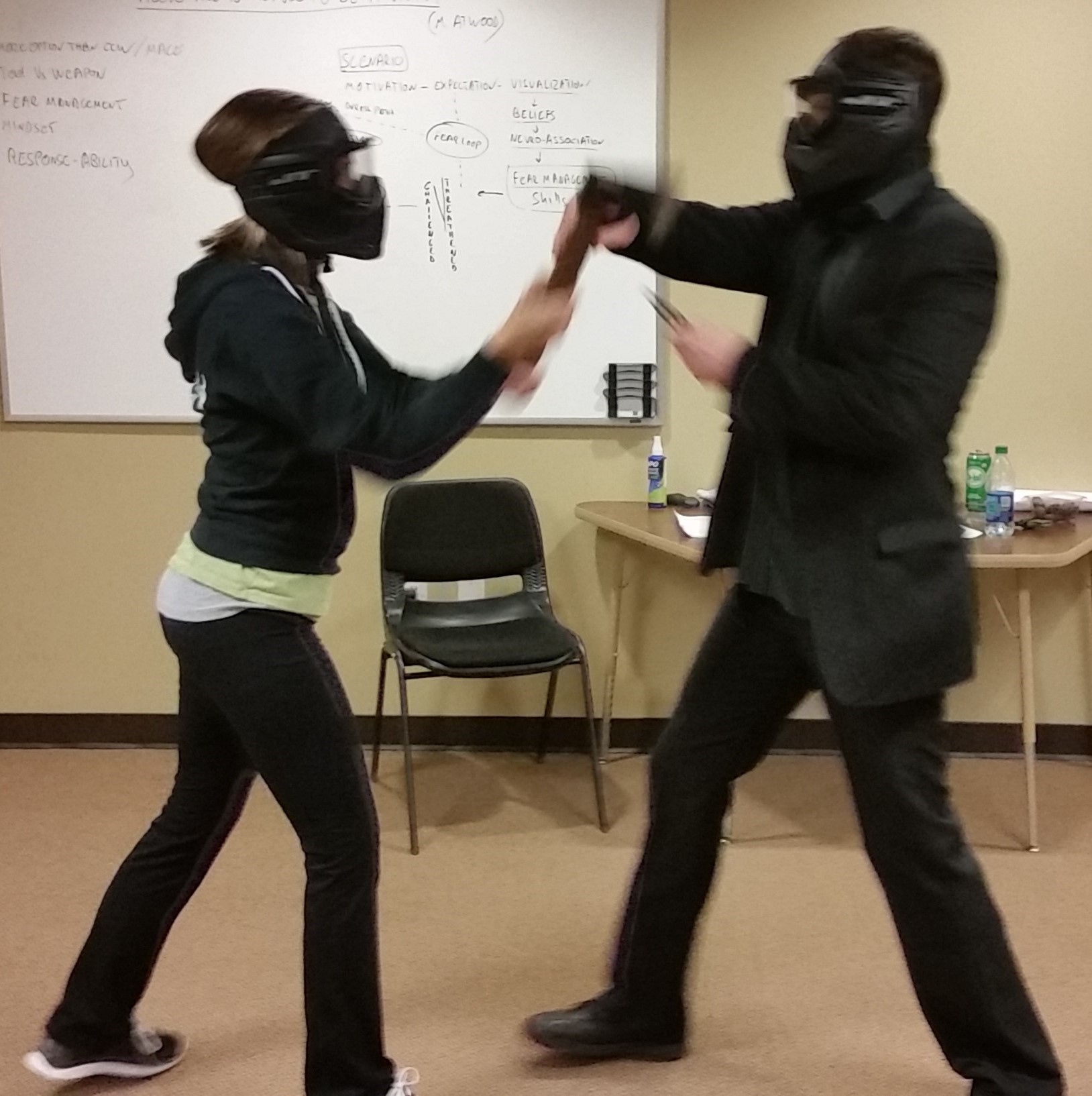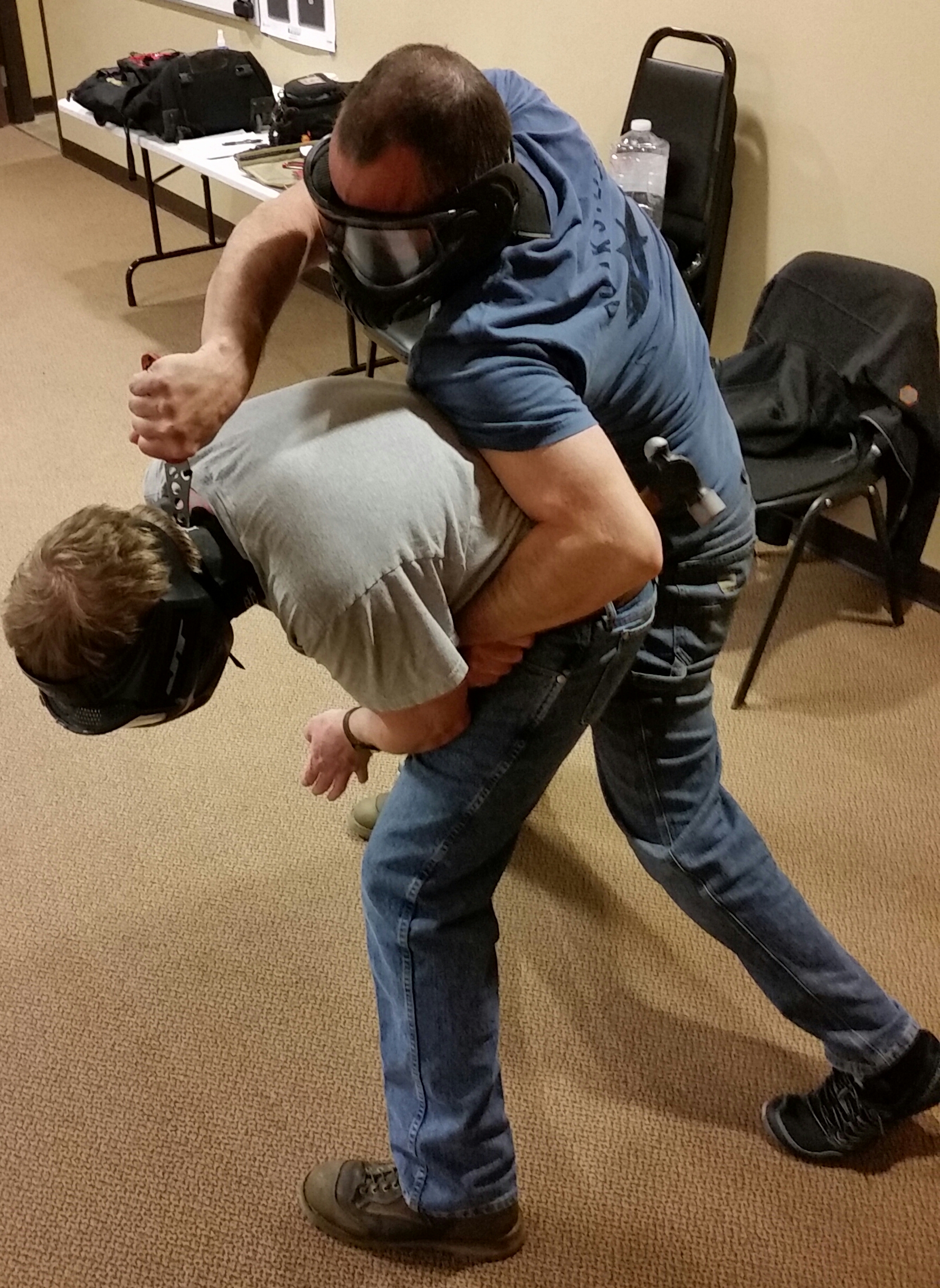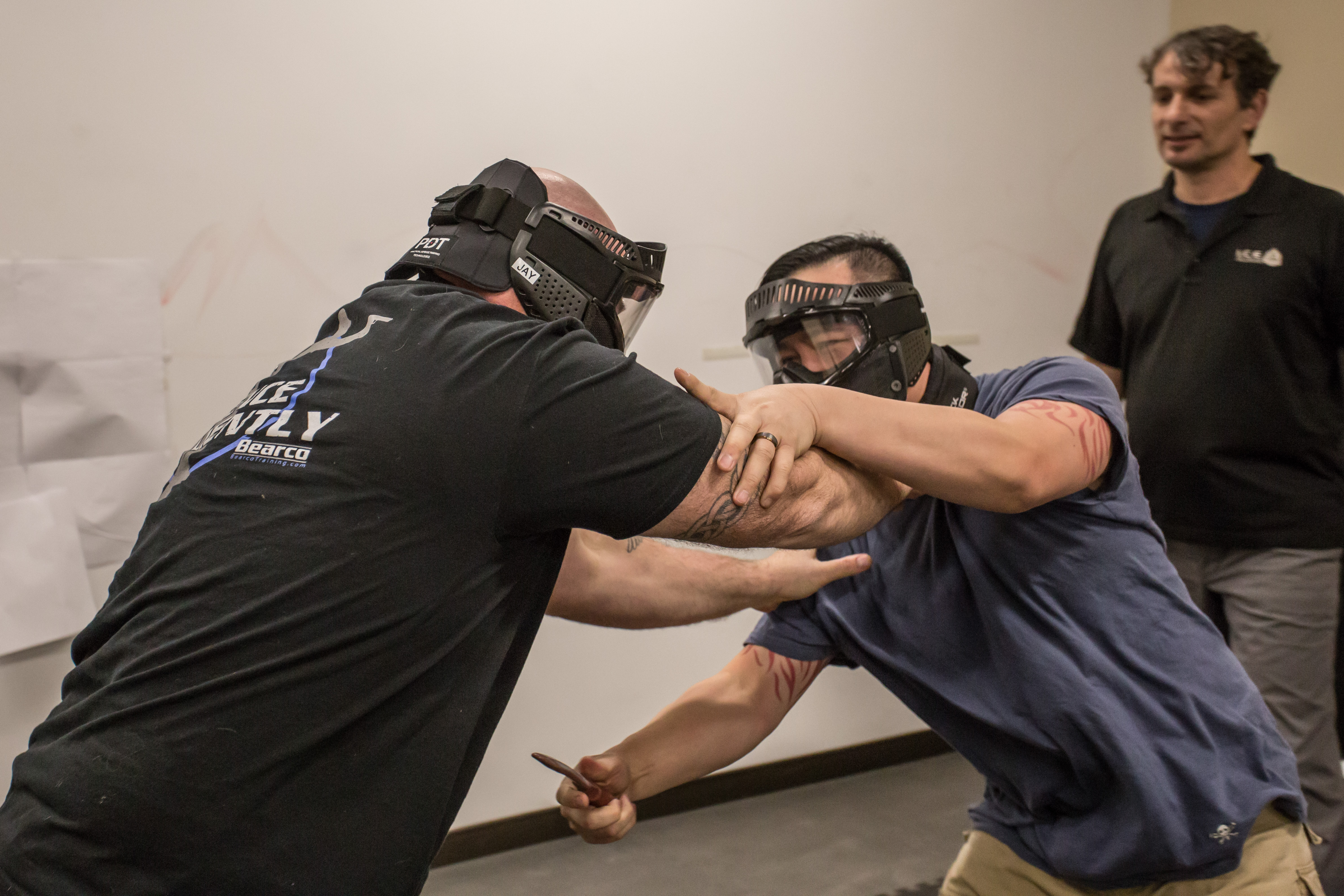Now we are going to discuss some psychological concepts and principles that can help students manage their innate reluctance to use violence. We will introduce some cognitive control techniques as well as drills that will help mitigate the particular revulsion they might feel about using a knife against another person.
Cognitive control techniques are designed to provide students with increased control over distracting or stress-inducing thoughts. They can be instrumental in managing fear and resolve.
HOW TO DIMINISH OUR INNATE RELUCTANCE TO USE VIOLENCE
This reluctance is a very interesting and important factor that we need to consider in order to develop the optimal mindset for self-defense. It is widely accepted that the reluctance to hurt or kill another human being may be innate, but it’s important to look at the whole picture. While it is true that these emotional responses are innate and difficult to change, it is also true that they were developed to benefit the members of our family and clan. Not outsiders.

Look in his eyes. Do you think he gave himself permission to use violence to stop a threat?
Photo: author
My hypothesis is that in our modern society, we have come very far from the daily life-and-death struggles of our ancestors. Most of us don’t have to kill to procure our food and have been sheltered, to various degrees, from interpersonal violence so effectively that we extend this “genetic courtesy” to non-members of our family and clan as well.
If we are serious about taking responsibility for our safety, we need to reacquire that distinction, to intuitively discriminate between non-threatening people who can rightly be considered part of our “extended” clan, and a violent and aggressive person, clearly a stranger, an outsider to our clan, a threat to our own survival.
Think about it: the aggressor is trying to take your body or your life. He is trying to prevent you from going home to your husband, wife, kids, sisters, brothers, parents, friends … it’s a long list. And everybody on that list wants you to fight back. They want to enjoy your company again. To smile, laugh and grow with you. What if this violent predator is trying to take a loved one away from you? How quickly the ability to visit violence becomes valuable, indispensable even, to our physical and psychological well-being, to our very survival.
COGNITIVE CONTROL TECHNIQUES
1. Permission
First the students need to come to terms with the hard fact that sometimes violence is the only available solution. They need to look within and reconcile that fact with whatever ethical, moral, religious, and philosophical values they may hold. They need to explicitly give themselves permission to hurt or kill a human being if their life or the lives of their loved ones are at risk. This decision cannot be taken during an attack because it will surely slow down their response. It needs to be taken ahead of time and it needs to be deliberate. Students should articulate it and write it on a piece of paper, preferably during class.
As an example, here is mine: “In order to protect my loved ones and myself, I’m ready and willing to use all the skills at my disposal (avoidance, de-escalation, defensive tactics, weapons) to stop the threat with the least amount of violence necessary.” These words are supported by my moral and ethical beliefs and are congruent with laws regulating self-defense. These words resonate deeply with me. Find words that resonate as deeply with you.
2. Positive Emotional Triggers
“A tribe including many members who … were always ready to give aid to each other and sacrifice themselves for the common good, would be victorious over most other tribes; and this would be natural selection.” (The Descent of Man, 1871, Charles Darwin)
But the true value of this genetic trait for our survival on any given day is psychological. When I’m focused on protecting someone, I’m not intimidated by thoughts about my safety and I’m much less prone to be distracted or give in to fear. My mind is free to focus solely on what I need to do to stop the threat.
If a loved one is present, they become my Positive Emotional Trigger, but I would like to reproduce that effect even when I’m alone. I want to mentally switch from “defend” to “protect,” from feeling threatened to feeling challenged.
I choose my wife as my Positive Emotional Trigger. If I find myself in danger, I visualize her right behind me. I am the only thing standing between her and the attacker. At that moment, I couldn’t care less about the consequences to my safety, about what may happen to me. All I want to do is stop the threat by any means necessary.
This is not bluster … try it. Sit down for a minute and visualize it. On an emotional level, the visualization of someone trying to hurt a loved one immediately elicits sheer indignation and rage. Rage is an extremely powerful emotion. It is an antidote to fear and has the potential to push us through our psychological barriers to use violence effectively.
HOW TO MANAGE OUR REVULSION TO USING A KNIFE AGAINST ANOTHER PERSON
In order to have a better chance at prevailing when attacked, we need to push through our psychological barriers to using a knife to stop a threat. We need to be able to use a knife and use it efficiently. To find the best way to achieve this, I started to research Stress Inoculation Training.
“In both medical and attitudinal inoculations, a person’s resistance is enhanced by exposure to a stimulus strong enough to arouse defenses and coping processes without being so powerful that it overwhelms the individual.” (Stress Inoculation Training, Donald Meichenbaum, 2007)
SIT was developed as clinical intervention designed to treat pathological psychiatric conditions, and is very effective at helping patients cope with the effects of traumatic experiences. One adaptation of SIT that became of particular interest to me was Stress Exposure Training, which takes a slightly different approach. Its general structure is similar to Meichenbaum’s cognitive behavioral approach, but SET differs from it in one very important way: it takes a proactive approach to stress inoculation. It is not a cure. It provides prophylaxis. It can prepare students for potential stressors and situations that they are likely to encounter.
I started to integrate SET into my program with very positive results. SET methodology is divided into three phases.
- 1. Information provision: Provides information on the human stress response, conditions participants should expect to encounter, and other preparatory information.
- 2. Skills acquisition: Designed to develop and refine behavioral, technical, and cognitive skills.
- 3. Application and practice: Includes practicing skills under conditions that approximate the operational environment and that gradually attain the level of stress expected. (Stress Inoculation Training, M. Lauria, 2015)
INFORMATION PROVISION
During this phase, I provide students with information about the reasons behind the difficulty most people have training to strike with a knife, and the targets they have most trouble attacking. I explain how we are going to train past that. We talk about the physiological effects that stress has on performance, and what they can expect going through the drills. I assure them that with proper training, they have the capacity to work past these inhibitions.
SKILLS ACQUISITION
This is a very important but often misunderstood phase. We need to develop the fundamental technical skills of how to use a knife efficiently, and develop them in as much context as possible. We have to do that in conjunction with the appropriate cognitive and behavioral techniques that will enable us to apply those skills under stress. A lot of people unfortunately miss these points and focus primarily on practicing the technical skills in very limited context, very possibly setting themselves up for failure.
The cognitive control techniques we talked about earlier can be implemented here in training. They are designed to change emotional condition: decrease fear and anxiety by substituting negative thoughts with positive, task-focused thoughts, and they are as important to train as our “tactics.”
The students have to gradually focus their strikes toward the face, neck and groin, and I push them to make contact through the target each time, whether they are stabbing or slashing. It is not easy for the students at first. You can see the coping process: students get nervous, giggle, joke, make faces, and generally try to switch to less intimate targets, like the limbs, torso and back. This is normal; they are working through the stressors that would normally inhibit them. At times I have to remind them of the increased efficacy of striking the more intimate targets, but eventually most students are able to consistently target the face, neck and groin areas.
That’s when we begin to gradually increase the complexity of the simulation. The student acting as the “anatomically correct dummy” starts to move and tries to hamper his partner’s defensive strikes so he/she learns to control the aggressor’s limbs, varying angles, trajectories, and strikes on the way to access the high-priority targets.
APPLICATION AND PRACTICE
This phase is designed to take the skills developed in phase two and apply them under increasingly stressful conditions. Sound familiar?

Training should challenge students by gradually increasing the intensity of the exercises.
Photo: author
In fact, when I put them through the first low-intensity scenarios, even under a moderate increase in the emotional load, most students revert to striking peripheral targets with poor follow-through. When that happens, the students have to go through scenarios with the same level of intensity until they can manage to strike through the priority targets. Only then is it beneficial to up the stress level. The cycle continues until they can apply the appropriate responses during high-intensity FoF scenarios.
Following these steps ensures that students will gain familiarity with the effects the stressors involved with using a knife cause. They will find ways to successfully cope with them emotionally and psychologically and will assertively practice the efficient application of their tactics, thus increasing their self-efficacy, confidence, and mindset.
I sincerely hope this series of articles has been beneficial to you and your students. Leave a comment below or contact me directly at ale@saferfasterdefense.com with any questions.






I love the quote from Dr. Peter R. Breggin. While I do not have the time nor money to attend the excellent training presented in these articles, I assure you that I shall keep all this info in mind as I go through my own self-defense preparations. I do so love the advice on imaging (or imagining) of defending oneself as if you are defending your loved ones. George Plimpton wrote that Detroit Lions All-Pro guard John Gordy, early in his career, would imagine while pass blocking, that his parents were seated in lawn chairs in the backfield. Later in his career he would envision his infant son in a stroller behind him. Great motivation in my book!
Very helpful, we will be implementing this information in our training
Your 3 part article is outstanding and delves into the prime areas of reluctance to engage in fighting with a blade. I understand the need for targeting, but many an attacker has been known to continue the fight even with direct stabs to some of the key areas you mention. The method of slashing key areas to debilitate the attacker's ability to continue the fight is sometimes more desirable and easier with practice. Key tendons that when slashed disable the ability to move or raise one's arm can allow a successful escape from a situation wouldn't you agree? It is also easier to slash a key section of the arm or leg than get even closer for an unsuccessful stab at the neck or groin.
Wen adult males are put through living on the street for years. You get the mine set that with knife pipe gun or any other item. To strike first with all your effort and without any remorse. Is the only way to survive. Wen I got a wife and kids did I learn to control the rage and I am street smart to know how humans will turn on you
I am a serious law-abiding citizen and therefore the strongest inhibitor I'm affected by, is that if I kill even the worst criminal, I may end up in jail and even be called "a criminal" myself.
One thought (actually two) Having a knife does not make you tougher than the other guy. That is, it may decrease his advantage over you, but he may still have an advantage. Having a knife makes the other guy tougher than you, that is, it will either decrease you advantage or increase his.
<strong>Where can i get that training in el paso tx.
As both a psychologist and former (low level) martial artist, I found your excellent series well researched and very helpful. I carry a Benchmade every day and occasionally take it out and practice a bit. I fenced foil for several years in college and this effectively desensitized me from any difficulty in stabbing folks who deserve it. My current offhand practice is slashing, learned by the sabre guys, but they were always selected to be shorter and stronger than the foil guys.
I took the time to read all 3 parts of your article on "Emotional Components Of Knife Defense" I found it ver relieving to learn that my response to the idea of being stabbed or stabbing someone else is natural and can be overcome with the right mindset and the right training. I have been carrying a fire arm for about 8 months and have recently added a knife to my EDC items. Thank you for the info and knowledgeable. It is a key step in my preparation to be able to defend myself and loved ones from a knife attack.
Very descriptive. I feel reality base training is the only someone can effectively learn. Using behaviorial based scenarios can place someone in the condition of a "ready or not" attitude. Enforces knowledge through muscle memory. Thanks.